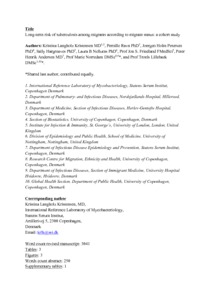Kristensen, KL; Ravn, P; Petersen, JH; Hargreaves, S; Nellums, LB; Friedland, JS; Andersen, PH; Norredam, M; Lillebaek, T
(2020)
Long-term risk of tuberculosis among migrants according to migrant status: a cohort study.
Int J Epidemiol, 49 (3).
pp. 776-785.
ISSN 1464-3685
https://doi.org/10.1093/ije/dyaa063
SGUL Authors: Friedland, Jonathan Samuel
![[img]](https://openaccess.sgul.ac.uk/111936/6.hassmallThumbnailVersion/KLK_Final_Long%20term%20risk%20of%20tuberculosis%20among%20migrants.pdf)  Preview |
|
PDF
Accepted Version
Available under License ["licenses_description_publisher" not defined].
Download (746kB)
| Preview
|
Abstract
BACKGROUND: The majority of tuberculosis (TB) cases in low-incidence countries occur in migrants. Only few studies have assessed the long-term TB risk in migrants after immigration, and datasets have not considered this across a range of diverse migrant groups. This nationwide study aimed to investigate long-term TB risk among migrants according to migrant status and region of origin. METHODS: This cohort study included all migrants aged ≥ 18 years who obtained residence in Denmark from 1993 to 2015, with a mean follow-up of 10.8 years [standard deviation (SD) 7.3]. Migrants were categorized based on legal status of residence and region of origin. Incidence rates (IR) and rate ratios (IRR) were estimated by Poisson regression. RESULTS: A total of 142 314 migrants were included. Across all migrants, the TB risk was highest during year 1 of residence (IR 275/100 000 person-years; 95% CI 249-305) followed by a gradual decline, though TB risk remained high for over a decade. Compared with the Danish-born population, the IRRs after 7-8 years were particularly higher among former asylum seekers (IRR 31; 95% CI 20-46), quota refugees (IRR 31; 95% CI 16-71), and family-reunified with refugees (IRR 22; 95% CI 12-44). Sub-Saharan African migrants also experienced elevated risk (IRR 75; 95% CI 51-109). The proportion of migrants with pulmonary TB was 52.4%. CONCLUSION: All migrant groups experienced an initial high TB risk, but long-term risk remained high in key migrant groups. Most European countries focus TB screening on or soon after arrival. Our study suggests that approaches to TB screening should be adapted, with migrant populations benefiting from long-term access to preventive health services.
| Item Type: |
Article
|
| Additional Information: |
This is a pre-copyedited, author-produced version of an article accepted for publication in International Journal of Epidemiology following peer review. The version of record Kristina Langholz Kristensen, Pernille Ravn, Joergen Holm Petersen, Sally Hargreaves, Laura B Nellums, Jon S Friedland, Peter Henrik Andersen, Marie Norredam, Troels Lillebaek, Long-term risk of tuberculosis among migrants according to migrant status: a cohort study, International Journal of Epidemiology, Volume 49, Issue 3, June 2020, Pages 776–785 is available online at: https://doi.org/10.1093/ije/dyaa063 |
| Keywords: |
Tuberculosis, asylum seekers, immigration, long-term risk, migrant, refugees, 0104 Statistics, 1117 Public Health and Health Services, Epidemiology |
| Journal or Publication Title: |
Int J Epidemiol |
| ISSN: |
1464-3685 |
| Language: |
eng |
| Dates: |
| Date | Event |
|---|
| June 2020 | Published | | 7 May 2020 | Published Online | | 25 March 2020 | Accepted |
|
| Publisher License: |
Publisher's own licence |
| PubMed ID: |
32380550 |
 |
Go to PubMed abstract |
| URI: |
https://openaccess.sgul.ac.uk/id/eprint/111936 |
| Publisher's version: |
https://doi.org/10.1093/ije/dyaa063 |
Statistics
Item downloaded times since 12 May 2020.
Actions (login required)
 |
Edit Item |



